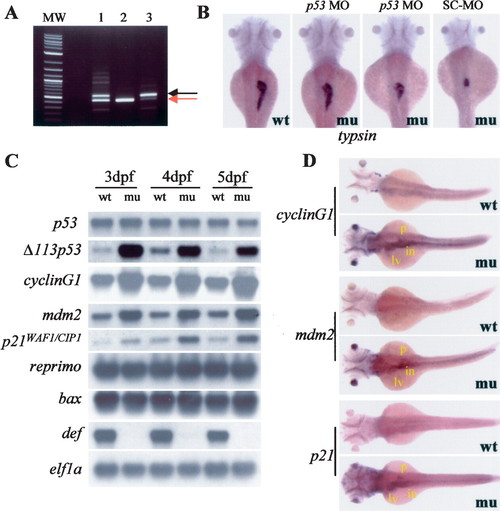Fig. 6
- ID
- ZDB-FIG-051220-28
- Publication
- Chen et al., 2005 - Loss of function of def selectively up-regulates {Delta}113p53 expression to arrest expansion growth of digestive organs in zebrafish
- Other Figures
- All Figure Page
- Back to All Figure Page
|
Cell proliferation-related but not proapoptotic-related p53 response genes are up-regulated in the defhi429 mutant. (A) RT-PCR analysis revealed that the p53 MO created an aberrant product with a larger size resulting from insertion of 89 bp from the intron 5. This 89-bp insertion introduced an early stop codon in the p53 mRNA. (MW) Molecular size marker; (lane 1) 0.5 mM p53 MO; (lane 2) standard control MO (SC-MO, human β-globin antisense morpholinos); (lane 3) 1.0 mM p53 MO; (red arrow) wild type p53; (black arrow) misspliced p53. (B) Injection of p53-MOspl targeting p53 mRNA rescued the mutant phenotype. Embryos 70 h post-injection were used for whole-mount in situ hybridization using a trypsin probe. (mu) Mutant; (wt) wild type. (C) Semiquantitative RT-PCR examination of expression of various p53 response genes in defhi429 mutant (mu) and the wild-type control (wt) at 3, 4, and 5 dpf, respectively. Homozygous defhi429 mutants (confirmed by lacking expression of def) had elevated levels of Δ113p53, cyclin G1, p21WAF1/CIP1, and mdm2 but unchanged levels of p53, reprimo, and bax when compared with the wild type (wt). (D) At 3 dpf, whole-mount in situ hybridization using cyclin G1, mdm2, and p21WAF1/CIP-1 probes showed that the expression of these genes was significantly and specifically increased in the digestive organs. (in) Intestine; (lv) liver; (p) pancreas. |
| Genes: | |
|---|---|
| Fish: | |
| Knockdown Reagent: | |
| Anatomical Terms: | |
| Stage Range: | Pec-fin to Day 5 |

